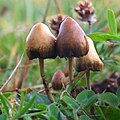Psilocybe
Psilocybe is a genus of fungi that belongs to the family Hymenogastraceae. It is commonly known as "magic mushrooms" due to the psychoactive compounds they contain. This genus comprises over 200 species, with Psilocybe cubensis being one of the most well-known and widely studied.
Description[edit]
Psilocybe mushrooms are characterized by their small to medium-sized fruiting bodies, which typically have a conical or bell-shaped cap. The cap color can vary from pale yellow to dark brown, depending on the species. The gills underneath the cap are usually dark purple to black, and they produce spores that aid in reproduction.
Psychoactive Compounds[edit]
Psilocybin and psilocin are the primary psychoactive compounds found in Psilocybe mushrooms. These compounds belong to a class of chemicals known as tryptamines. Psilocybin is a prodrug, meaning it is converted into psilocin when ingested. Psilocin is responsible for the hallucinogenic effects experienced by individuals who consume these mushrooms.
Historical and Cultural Significance[edit]
The use of Psilocybe mushrooms for their psychoactive properties dates back centuries and has been documented in various cultures around the world. Indigenous peoples in Mesoamerica, such as the Aztecs and the Maya, used these mushrooms in religious and spiritual ceremonies. They believed that consuming Psilocybe mushrooms allowed them to communicate with the divine and gain insight into the nature of reality.
Effects and Potential Benefits[edit]
When ingested, Psilocybe mushrooms can induce a range of effects, including altered perception, visual hallucinations, euphoria, and introspective experiences. These effects are highly subjective and can vary depending on the individual, dosage, and set and setting. Research suggests that psilocybin-assisted therapy may have potential benefits in treating various mental health conditions, such as depression, anxiety, and addiction.
Legal Status[edit]
The legal status of Psilocybe mushrooms varies across different countries and jurisdictions. In some places, such as Brazil and Jamaica, the use and possession of these mushrooms are legal. However, in many countries, including the United States and most of Europe, Psilocybe mushrooms are classified as controlled substances, making their possession, cultivation, and distribution illegal.
Conservation and Ecological Importance[edit]
Psilocybe mushrooms play a vital role in ecosystems as decomposers. They break down organic matter, such as dead plant material, and help recycle nutrients back into the soil. Additionally, some species of Psilocybe have symbiotic relationships with trees, forming mycorrhizal associations that benefit both the fungi and the host plants.
See Also[edit]
References[edit]
<references />
-
Psilocybe
-
Psilocybe
-
Psilocybe
-
Psilocybe
-
Psilocybe
-
Psilocybe
-
Psilocybe
-
Psilocybe
-
Psilocybe
-
Psilocybe
Ad. Transform your life with W8MD's Budget GLP-1 injections from $75


W8MD offers a medical weight loss program to lose weight in Philadelphia. Our physician-supervised medical weight loss provides:
- Weight loss injections in NYC (generic and brand names):
- Zepbound / Mounjaro, Wegovy / Ozempic, Saxenda
- Most insurances accepted or discounted self-pay rates. We will obtain insurance prior authorizations if needed.
- Generic GLP1 weight loss injections from $75 for the starting dose.
- Also offer prescription weight loss medications including Phentermine, Qsymia, Diethylpropion, Contrave etc.
NYC weight loss doctor appointmentsNYC weight loss doctor appointments
Start your NYC weight loss journey today at our NYC medical weight loss and Philadelphia medical weight loss clinics.
- Call 718-946-5500 to lose weight in NYC or for medical weight loss in Philadelphia 215-676-2334.
- Tags:NYC medical weight loss, Philadelphia lose weight Zepbound NYC, Budget GLP1 weight loss injections, Wegovy Philadelphia, Wegovy NYC, Philadelphia medical weight loss, Brookly weight loss and Wegovy NYC
|
WikiMD's Wellness Encyclopedia |
| Let Food Be Thy Medicine Medicine Thy Food - Hippocrates |
Medical Disclaimer: WikiMD is not a substitute for professional medical advice. The information on WikiMD is provided as an information resource only, may be incorrect, outdated or misleading, and is not to be used or relied on for any diagnostic or treatment purposes. Please consult your health care provider before making any healthcare decisions or for guidance about a specific medical condition. WikiMD expressly disclaims responsibility, and shall have no liability, for any damages, loss, injury, or liability whatsoever suffered as a result of your reliance on the information contained in this site. By visiting this site you agree to the foregoing terms and conditions, which may from time to time be changed or supplemented by WikiMD. If you do not agree to the foregoing terms and conditions, you should not enter or use this site. See full disclaimer.
Credits:Most images are courtesy of Wikimedia commons, and templates, categories Wikipedia, licensed under CC BY SA or similar.
Translate this page: - East Asian
中文,
日本,
한국어,
South Asian
हिन्दी,
தமிழ்,
తెలుగు,
Urdu,
ಕನ್ನಡ,
Southeast Asian
Indonesian,
Vietnamese,
Thai,
မြန်မာဘာသာ,
বাংলা
European
español,
Deutsch,
français,
Greek,
português do Brasil,
polski,
română,
русский,
Nederlands,
norsk,
svenska,
suomi,
Italian
Middle Eastern & African
عربى,
Turkish,
Persian,
Hebrew,
Afrikaans,
isiZulu,
Kiswahili,
Other
Bulgarian,
Hungarian,
Czech,
Swedish,
മലയാളം,
मराठी,
ਪੰਜਾਬੀ,
ગુજરાતી,
Portuguese,
Ukrainian









